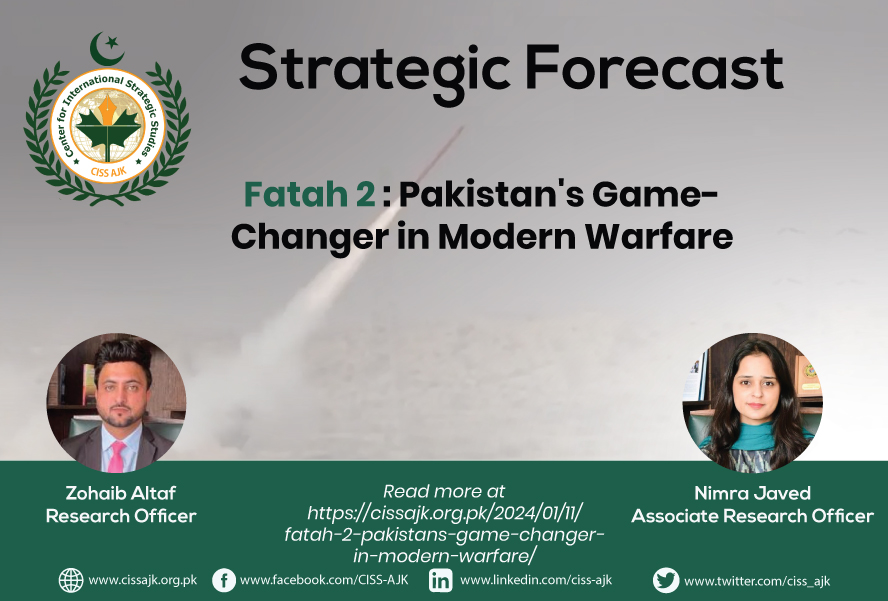The recent unveiling of Pakistan’s Fatah 2 missile marks a significant milestone in the evolution of contemporary military technology, underscoring the dynamic nature of modern warfare. This development in Pakistan’s missile technology, particularly with the indigenous long-range precision strike weapon Fatah 2, is a testament to its growing proficiency in missile technology and strategic warfare. Boasting an impressive range of approximately 249 miles, the Fatah 2 significantly surpasses its predecessor, the Fatah 1, in both range and capabilities. This advancement not only demonstrates the remarkable progress in technology but also mirrors the evolving landscape of military strategies worldwide.
The Fatah 2, an advanced armament system, is equipped with modern avionics and a cutting-edge navigation system, representing a significant upgrade over the Fatah 1. It is mounted on the robust Taian TAS5450 eight-wheel drive chassis, enhancing the missile’s launch system mobility and stability. This chassis is also employed in other sophisticated artillery systems, attesting to its reliability and effectiveness.
In the design and development of the Fatah 2, a clear emphasis was placed on accuracy and versatility. The missile’s advanced guidance technology and extended range enable it to strike distant strategic targets with remarkable precision. The capability to engage targets accurately at long ranges without sacrificing precision is crucial in modern warfare.
The deployment of precision artillery and drone technologies marks a pivotal moment in military history. Precision artillery, with its ability to minimize collateral damage and increase accuracy, allows for targeted strikes on specific enemy assets, reducing the overall impact of military operations. This precision is critical in contemporary conflicts, especially given the high political cost of civilian casualties and the increasingly blurred lines between combatant and non-combatant zones.
Drone technology further amplifies these capabilities. Unmanned aerial vehicles (UAVs) facilitate the safe execution of attack, reconnaissance, and surveillance missions. Equipped with precision-guided munitions, drones can strike targets with exceptional accuracy, greatly enhancing missions that require judgment and precision.
Strategically employing cost-effective precision weapons like the Fatah 2 enables the conservation of more sophisticated and expensive military assets. High-end armaments such as manned fighter jets are deployed only when their unique capabilities are essential. This approach maximizes the use of all asset types, ensuring that valuable platforms remain operational and well-maintained for critical situations. In an era of escalating costs for advanced military equipment, this signifies a more judicious and effective allocation of military resources.
A key aspect of contemporary military strategy is the potential of the Fatah 2 missile to neutralize advanced air defense systems like India’s S-400. Compared to traditional air attack methodologies, the S-400’s advanced tracking and interception capabilities are formidable. The Fatah 2 could serve as a decoy, diverting these defense systems and creating opportunities for other offensive assets, such as combat drones, to exploit.
Engaging and neutralizing sophisticated defense systems in modern warfare is a challenging task that requires innovative tactics like these. The use of a missile as a decoy in conjunction with drone attacks demonstrates a complex operational strategy that integrates multiple weapon systems to achieve a singular strategic objective.
The essence of integrated warfare tactics is the coordinated employment of diverse weapon systems. This approach embodies a composite offensive strategy that incorporates elements of air, land, and electronic warfare. In these multidimensional operations, adversaries are confronted with threats across multiple domains simultaneously, complicating their defensive measures and rendering them more vulnerable.
Effective integrated warfare requires more than just advanced armaments; it necessitates thorough planning and coordination. Understanding how to synchronize the operations of each asset to maximize their collective impact, and having a comprehensive knowledge of their individual strengths and weaknesses, are essential. This level of complexity in planning and execution reflects a mature and nuanced approach to contemporary military engagements.
Several factors are driving the increasing prominence of precision weapons as a cornerstone of military strategy. Firstly, there is a growing imperative to reduce civilian casualties and collateral damage, as modern battles often occur in densely populated urban environments. Precision weapons address these needs effectively. Secondly, there is a need for efficient and reliable weapons to counter the growing sophistication and resilience of adversary defense systems. Precision weapons, with their advanced guidance systems, are ideally suited to meet this challenge. Lastly, precision weapons align well with the current geopolitical landscape, characterized by complex international relations and the necessity for discrete military actions. They allow for targeted strikes that achieve specific objectives without escalating to full-scale war.
In conclusion, the advancement of Pakistan’s Fatah 2 missile exemplifies a shift in military strategy towards integration, efficiency, and precision. This shift is indicative of a broader trend in military strategy towards the deployment of an array of precision weapons designed for specific purposes. These solutions address the intricate challenges of modern warfare and enhance the efficacy of military operations. As nations continue to upgrade their military capabilities, precision and strategic integration are poised to become central themes in future global military conflicts.
Authors: Zohaib Altaf is Research officer at Center for International Strategic Studies, AJK. He is working on the Nuclear Politics and Strategies and Emerging Technologies. He has written for numerous national and international publications.
Nimra Javed is Researcher at Center for International Strategic Studies, AJK. She is working on the Nuclear Politics and Strategies and Emerging Technologies. She has written for numerous national and international publications.

